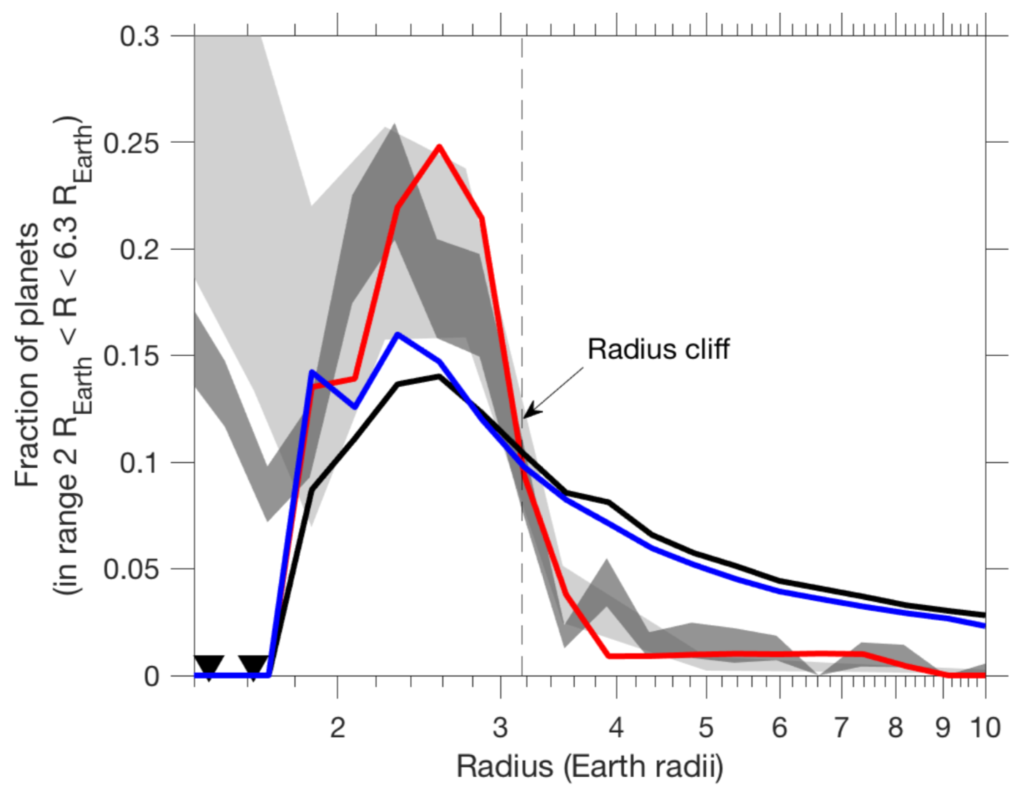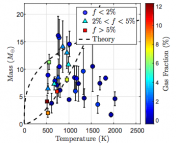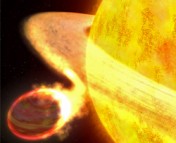Title: Superabundance of Exoplanet Sub-Neptunes Explained by Fugacity Crisis
Authors: Edwin S. Kite, et al.
First Author’s Institution: University of Chicago
Status: open access on arXiv
In the few decades since the discovery of the first exoplanet in 1992, we’ve realized that our own solar system is just plain weird. We have no hot Jupiter gas giant planets whizzing around our star in a matter of days, nor do we have any sub-Neptune planets, the most common type of planet in the galaxy. Critically, our lack of sub-Neptunes severely hinders our understanding of the transition between Earth-like and Neptune-like planets.
The Kepler Space Telescope operated from 2009—2018 and discovered over 2600 exoplanets, nearly 1000 of which were classified as sub-Neptunes. But Neptune-like planets are considerably rarer, despite being only slightly bigger. This “radius cliff” (Fig. 1) separates sub-Neptunes (radii < 3 R, where R
is Earth’s radius) from Neptunes (radii > 3 R
). What could cause such a steep dropoff? Today’s authors explore this question.
Previous Model Shortcomings
Gas giant planets are made primarily of…well…gas. Specifically, most of this gas is molecular hydrogen, H2. Smaller gas giants like Neptune and Uranus have a larger fraction of helium and methane than planets like Jupiter or Saturn, but their atmospheres are still primarily hydrogen (Fig. 2). Previous attempts to explain the sub-Neptune radius cliff have therefore focused on atmospheric hydrogen loss and accretion.
In one model, researchers proposed that larger atmospheres (when considered with the same core mass) are easier to strip away. However, this model can’t explain both the wide range of sub-Neptune masses and the radius cliff. Other researchers have looked instead at the flipside — accreting more atmosphere just as the protoplanetary disk dissipates. As the disk disappears, the planet’s source of atmosphere disappears, cutting off the planet’s growth. But this model depends closely on the properties of the disk and how long it lives, so the model is likely not the universal solution to the radius cliff problem. What, then, can explain it?
An Active Core
One critical assumption that both of the previous explanations incorporated is that they left the planetary core chemically and thermally inert. That is, it does not interact at all with the atmosphere. Our own experiences on Earth, from the wavy lines radiating from the road on a hot day to the very existence of the water and carbon cycles, suggest that an inert core may not be a valid assumption (even though Earth is structured differently than a gas giant).
Today’s authors throw out the assumption that the core does not interact with the atmosphere. Additionally, the deep atmospheres of gas giants insulate and slow down the cooling of their cores, which results in a magma ocean that directly touches the atmosphere. The authors then look at how the solubility of H2 in magma depends on various atmospheric properties such as pressure and temperature.
The immense pressures at the magma-atmosphere interface mean that the properties of the gasses no longer follow the Ideal Gas Law. Instead, they behave non-linearly. In such high-pressure situations, the H2 molecules are so squished together that they begin to repel each other and can no longer be compressed. In this case, the only place the H2 can go is down, into the magma. Furthermore, the H2 no longer dissolves linearly (as in Henry’s Law) due to the high pressures. Therefore, as more and more gas accretes onto the atmosphere, more and more H2 dissolves into the magma, and the planet’s overall radius growth stalls. The authors call this non-linear solubility property of highly-pressurized H2 the “fugacity crisis,” where fugacity refers to a gas’s tendency to dissolve into an adjacent liquid.
The authors find that sub-Neptunes with radii between 2-3 R are so numerous because the atmospheres of planets that size reach the pressures required to force the H2 into the magma ocean. Then, once the magma ocean saturates, planetary radius growth can resume. However, planets that have enough gas to reach beyond the saturation point are much rarer, simply because they require much more gas. Hence, the radius cliff!

Toward a more complete description of sub-Neptunes
Today’s paper shows the importance of revisiting assumptions and considering additional factors to explain interesting phenomena. Even though the authors reproduced the radius cliff separating sub-Neptunes from Neptunes, they note that further research remains. Essentially no laboratory data exists about the true solubility of H2 in magma at the temperatures and pressures that exist in the depths of sub-Neptunes because no Earth-bound container can hold that magma. The authors instead extrapolated from lower temperature and pressure measurements. Additionally, the magma-atmosphere interface likely isn’t a hard boundary but rather more fuzzy, which would likely change how the H2 dissolves into the magma. Finally, the authors note that different core compositions would also likely change the interactions of the magma with the atmosphere.
On the plus side, the authors’ non-linear H2 dissolving model makes a number of predictions, including how steep the radius cliff is, non-dependence on planetary disk conditions, and the ratios of molecules present in sub-Neptune atmospheres. Future data from TESS will allow astronomers to test this latest hypothesis and bring us a step closer to understanding how planets form.




